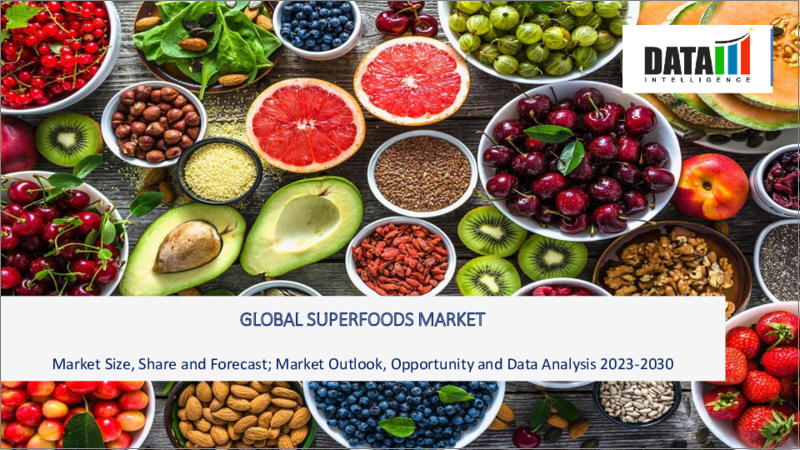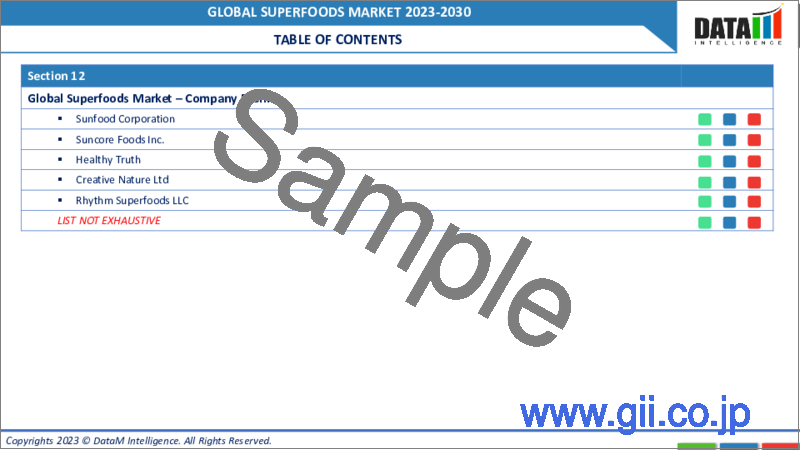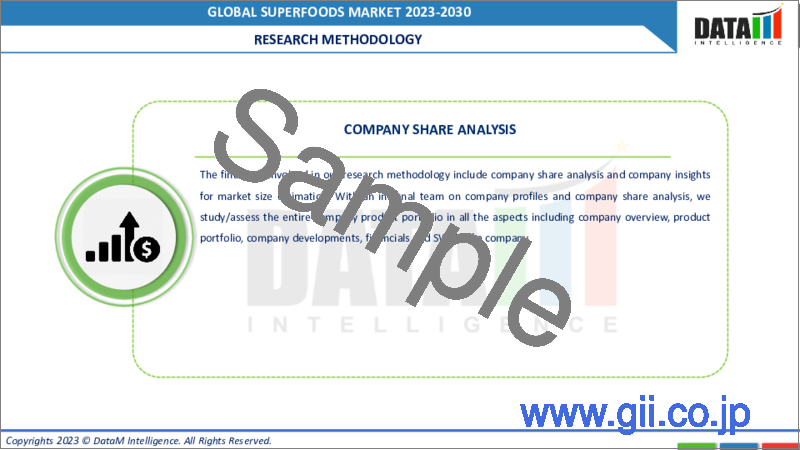|
|
市場調査レポート
商品コード
1319168
スーパーフードの世界市場-2023年~2030年Global Superfoods Market - 2023-2030 |
||||||
カスタマイズ可能
適宜更新あり
|
|||||||
| スーパーフードの世界市場-2023年~2030年 |
|
出版日: 2023年07月31日
発行: DataM Intelligence
ページ情報: 英文 190 Pages
納期: 即日から翌営業日
|
- 全表示
- 概要
- 目次
市場概要
世界のスーパーフード市場は、2022年に1,552億米ドルに達し、2030年には2,958億米ドルに達すると予測され、予測期間2023-2030年のCAGRは8.4%で成長すると予測されています。スーパーフード市場の動向の一つは、機能性飲料に対する需要の高まりです。例えば、ほうれん草、ケール、アボカドなどのスーパーフード原料を使ったグリーンスムージーの人気が健康志向の消費者の間で急上昇しています。
スーパーフード市場は、より健康的で栄養密度の高い食品オプションに対する消費者の需要の高まりによって、大きな成長を遂げています。スーパーフードは、ビタミン、ミネラル、抗酸化物質、その他の有益な化合物を多く含むことで知られています。スーパーフードは、免疫機能の改善、体重管理、エネルギーレベルの向上など、潜在的な健康上の利点があるとして注目されています。
予防ヘルスケアに対する消費者の関心の高まりは、スーパーフード市場の主要な促進要因です。例えば、ブルーベリーやストロベリーなどのベリー類の健康効果に対する意識の高まりが、スーパーフードとしての需要を押し上げています。これらのベリー類には抗酸化物質や植物化学物質が豊富に含まれており、慢性疾患に対する予防効果があると考えられています。消費者は、総合的な健康と幸福をサポートするために、こうしたスーパーフードを積極的に求めています。
市場力学
消費者の健康志向の高まりがスーパーフードの需要を後押し
スーパーフードサプリメントに含まれる健康的な脂肪は、心臓病のリスクを下げるのに役立ちます。スーパーフードに含まれる食物繊維は、健康的な血糖値を維持し、消化を促進します。植物性スーパーフードに含まれるフィトケミカル(植物化学物質)の治癒力で、心臓血管の健康を守りましょう。機能的で栄養豊富なスーパーフードで、全身の健康を高めましょう。
機能性食品と栄養密度の高いスーパーフードが市場成長を牽引しています
機能性食品と栄養密度の高い食品に対する需要の高まりが、スーパーフード市場の主要促進要因です。機能性食品とは、基本的な栄養を超えたその他の健康上のメリットを提供する食品を指します。こうした食品は多くの場合、ビタミン、ミネラル、または特定の健康機能を促進する生物活性化合物で強化されています。消費者は、総合的な健康を支え、特定の健康上の懸念に対処するために、機能性食品を求めるようになっています。
一方、栄養密度の高い食品とは、カロリー当たりの必須栄養素の濃度が高い食品のことです。ビタミン、ミネラル、抗酸化物質、その他の有益な化合物が詰まっており、一口ごとに最適な栄養を摂取することができます。機能性食品と栄養密度の高い食品の重視は、健康維持における栄養の重要性に対する意識の高まりと一致しています。
スーパーフード市場は誤解を招く宣伝文句と規格の欠如という課題に直面しています
スーパーフード市場の主な抑制要因の1つは、誤解を招く健康強調表示の可能性と標準化された定義の欠如です。スーパーフードの人気が高まるにつれて、特定の製品が誇張した、あるいは根拠のない健康強調表示を行うリスクがあります。これは、消費者に混乱をもたらし、市場の信頼性を損なう可能性があります。
さらに、スーパーフードの定義や規制が統一されていないため、矛盾や誤解が生じる可能性もあります。明確なガイドラインがなければ、栄養価の低い食品がスーパーフードとして販売される可能性があり、市場の健全性が損なわれます。スーパーフード市場の持続的な成長を確保するためには、正確な表示と消費者にとって信頼できる情報を促進する透明性のある基準とガイドラインを確立することが極めて重要です。
COVID-19影響分析
COVID-19分析には、COVID前シナリオ、COVIDシナリオ、COVID後シナリオに加え、価格力学(COVID前シナリオと比較したパンデミック中およびパンデミック後の価格変動を含む)、需給スペクトラム(取引制限、封鎖、およびその後の問題による需給の変化)、政府の取り組み(政府機関による市場、セクター、産業を活性化するための取り組み)、メーカーの戦略的取り組み(COVID問題を緩和するためにメーカーが行ったことをここで取り上げる)が含まれます。
目次
第1章 調査手法と調査範囲
第2章 市場の定義と概要
第3章 エグゼクティブサマリー
第4章 市場力学
- 市場への影響要因
- 促進要因
- 抑制要因
- 機会
- 影響分析
第5章 産業分析
- ポーターのファイブフォース分析
- サプライチェーン分析
- 価格分析
- 規制分析
第6章 COVID-19分析
第7章 製品タイプ別
- 果物
- 野菜
- 穀物・種子
- ハーブ・根菜
- 肉類
- その他
第8章 用途別
- ベーカリー・菓子類
- 飲料
- サプリメント
- コンビニエンス/RTE食品
- その他
第9章 流通チャネル別
- スーパーマーケット/ハイパーマーケット
- コンビニエンスストア
- オンラインストア
- その他
第10章 地域別
- 北米
- 米国
- カナダ
- メキシコ
- 欧州
- ドイツ
- 英国
- フランス
- イタリア
- スペイン
- その他欧州
- 南米
- ブラジル
- アルゼンチン
- その他南米
- アジア太平洋
- 中国
- インド
- 日本
- オーストラリア
- その他アジア太平洋地域
- 中東・アフリカ
第11章 競合情勢
- 競合シナリオ
- 市況/シェア分析
- M&A分析
第12章 企業プロファイル
- Archer-Daniels-Midland Company
- 会社概要
- 製品ポートフォリオと説明
- 財務概要
- 主な発展
- Del Monte Pacific Group
- Navitas LLC
- Nutrisure Limited
- OMG Superfoods
- Sunfood Corporation
- Suncore Foods Inc
- Healthy Truth
- Creative Nature Ltd
- Rhythm Superfoods LLC
第13章 付録
Market Overview
The Global Superfoods Market reached US$ 155.2 billion in 2022 and is expected to reach US$ 295.8 billion by 2030 and is expected to grow with a CAGR of 8.4% during the forecast period 2023-2030. One trend in the superfoods market is the growing demand for functional beverages. For instance, the popularity of green smoothies made with superfood ingredients like spinach, kale, and avocado has surged among health-conscious consumers.
The superfoods market is experiencing significant growth and is driven by the increasing consumer demand for healthier and nutrient-dense food options. Superfoods are known for their high content of vitamins, minerals, antioxidants, and other beneficial compounds. They are sought after for their potential health benefits, including improved immune function, weight management, and increased energy levels.
The increasing consumer focus on preventive healthcare is a key driver in the superfoods market. For instance, the rising awareness of the health benefits of berries, such as blueberries and strawberries, has driven their demand as superfoods. These berries are rich in antioxidants and phytochemicals, which are believed to have protective effects against chronic diseases. Consumers are actively seeking out these superfoods to support their overall health and well-being.
Market Dynamics
Rising Health Consciousness Among the Consumers Fuels Demand for Superfoods
Supercharge your health with plant-based superfoods, superfood powders, and supplements! harness the incredible benefits of nutrient-dense plant-based superfoods to boost your well-being. Incorporating these powerhouse foods into your balanced diet can enhance heart health, support weight loss, increase energy levels, and promote anti-aging effects. Discover the antioxidant-rich food's properties of superfood powders and their potential in preventing cancer.
The inclusion of healthy fats in superfood supplements can help lower the risk of heart disease. Benefit from the fiber content in these superfoods to maintain healthy blood sugar levels and promote digestive wellness. Embrace the healing power of phytochemicals found in plant-based superfoods, protecting your cardiovascular health. Elevate your overall health with these functional and nutrient-dense superfoods.
Functional Foods and Nutrient-Dense Superfoods are Driving the Market Growth
The rising demand for functional foods and nutrient-dense foods is a major driver in the superfoods market. Functional foods refer to those that offer additional health benefits beyond basic nutrition. These foods are often fortified with vitamins, minerals, or bioactive compounds that promote specific health functions. Consumers are increasingly seeking out functional foods to support their overall well-being and address specific health concerns.
Nutrient-dense foods, on the other hand, are those that provide a high concentration of essential nutrients per calorie. They are packed with vitamins, minerals, antioxidants, and other beneficial compounds, offering optimal nutrition in every bite. The emphasis on functional foods and nutrient-dense foods aligns with the growing awareness of the importance of nutrition in maintaining good health.
Superfoods Market Faces Challenges of Misleading Claims and Lack of Standards
One key restraint of the superfoods market is the potential for misleading health claims and lack of standardized definitions. As the popularity of superfoods continues to grow, there is a risk of exaggerated or unsubstantiated health claims being made by certain products. This can create confusion among consumers and undermine the credibility of the market.
Additionally, the lack of standardized definitions and regulations for what qualifies as a superfood can lead to inconsistency and misinterpretation. Without clear guidelines, there is a possibility of less nutritious foods being marketed as superfoods, diluting the market's integrity. To ensure the sustainable growth of the superfood market, it is crucial to establish transparent standards and guidelines that promote accurate labeling and reliable information for consumers.
COVID-19 Impact Analysis
The COVID-19 Analysis includes Pre-COVID Scenario, COVID Scenario, and Post-COVID Scenario along with Pricing Dynamics (Including pricing change during and post-pandemic comparing it to pre-COVID scenarios), Demand-Supply Spectrum (Shift in demand and supply owing to trading restrictions, lockdown, and subsequent issues), Government Initiatives (Initiatives to revive market, sector or Industry by Government Bodies) and Manufacturers Strategic Initiatives (What manufacturers did to mitigate the COVID issues will be covered here).
Segment Analysis
The global superfoods market has been segmented by product type, application, distribution channel, and region.
Vegetables are a Powerhouse of Health-Promoting Nutrients and Antioxidants in the Superfoods Market
The second largest segment in the superfoods market is vegetables, accounting for approximately 25% of the market share. Vegetables are known for their significant health-promoting properties, making them a vital component of a nutritious diet. Packed with essential vitamins, minerals, and dietary fiber, vegetables are considered health-promoting foods that support overall well-being.
They are rich in antioxidants, such as vitamins C and E, as well as phytochemicals, which play a crucial role in protecting the body against harmful free radicals and reducing the risk of chronic diseases. Certain vegetables also exhibit adaptogenic properties, helping the body adapt to stress and maintain balance. With their diverse range of colors, flavors, and textures, vegetables offer abundant options to incorporate into meals and enhance the nutritional profile of any diet.
Geographical Analysis
Asia Pacific Emerges as the Fastest Growing Region in the Superfoods Market, Propelled by Health-conscious Consumers
By region, the global superfoods market is segmented into North America, South America, Europe, Asia-Pacific, Middle-east, and Africa.
The Asia Pacific region is experiencing remarkable growth in the superfoods market, outpacing other regions in terms of expansion. The superfoods market share in Asia Pacific is driven by a surge in health-conscious consumers who prioritize nutritious food choices. With a focus on preventive healthcare and holistic well-being, the demand for superfoods in the region is soaring.
The superfoods market size in Asia Pacific is witnessing significant growth as more consumers embrace the benefits of superfoods in their diets. The region's diverse culinary heritage, coupled with the abundance of indigenous superfoods, further amplifies its position as the fastest-growing region in the global superfoods market. Companies are capitalizing on this thriving market by offering a wide variety of superfoods tailored to the unique tastes and preferences of Asian consumers.
Competitive Landscape
The major global players in the market include: Archer-Daniels-Midland Company, Del Monte Pacific Group, Navitas LLC, Nutrisure Limited, OMG Superfoods, Sunfood Corporation, Suncore Foods Inc, Healthy Truth, Creative Nature Ltd, and Rhythm Superfoods LLC.
Why Purchase the Report?
- To visualize the global Superfoods market segmentation based on product type, application, distribution channel, and region, as well as understand key commercial assets and players.
- Identify commercial opportunities in the market by analyzing trends and co-development.
- Excel data sheet with numerous data points of superfoods market-level with all segments.
- The PDF report consists of a cogently put-together market analysis after exhaustive qualitative interviews and an in-depth market study.
- Product mapping is available as Excel consists of key products of all the major market players.
The global Superfoods market report would provide approximately 61 tables, 63 figures, and 190 Pages.
Target Audience 2023
- Manufacturers/ Buyers
- Industry Investors/Investment Bankers
- Research Professionals
- Emerging Companies
Table of Contents
1. Methodology and Scope
- 1.1. Research Methodology
- 1.2. Research Objective and Scope of the Report
2. Market Definition and Overview
3. Executive Summary
- 3.1. Market Snippet, by Product Type
- 3.2. Market Snippet, by Application
- 3.3. Market Snippet, by Distribution Channel
- 3.4. Market Snippet, by Region
4. Market Dynamics
- 4.1. Market Impacting Factors
- 4.1.1. Drivers
- 4.1.2. Restraints
- 4.1.3. Opportunity
- 4.1.4. Impact Analysis
5. Industry Analysis
- 5.1. Porter's Five Force Analysis
- 5.2. Supply Chain Analysis
- 5.3. Pricing Analysis
- 5.4. Regulatory Analysis
6. COVID-19 Analysis
- 6.1. Analysis of COVID-19 on the Market
- 6.1.1. Scenario Before COVID-19
- 6.1.2. Scenario During COVID-19
- 6.1.3. Scenario Post COVID-19
- 6.2. Pricing Dynamics Amid COVID-19
- 6.3. Demand-Supply Spectrum
- 6.4. Government Initiatives Related to the Market During the Pandemic
- 6.5. Manufacturer's Strategic Initiatives
- 6.6. Conclusion
7. By Product Type
- 7.1. Introduction
- 7.1.1. Market Size Analysis and Y-o-Y Growth Analysis (%), By Product Type
- 7.1.2. Market Attractiveness Index, By Product Type
- 7.2. Fruits*
- 7.2.1. Introduction
- 7.2.2. Market Size Analysis and Y-o-Y Growth Analysis (%)
- 7.3. Vegetables
- 7.4. Grains & Seeds
- 7.5. Herbs & Roots
- 7.6. Meat
- 7.7. Others
8. By Application
- 8.1. Introduction
- 8.1.1. Market Size Analysis and Y-o-Y Growth Analysis (%), By Application
- 8.1.2. Market Attractiveness Index, By Application
- 8.2. Bakery and Confectionery*
- 8.2.1. Introduction
- 8.2.2. Market Size Analysis and Y-o-Y Growth Analysis (%)
- 8.3. Beverages
- 8.4. Supplements
- 8.5. Convenience/Ready-to-Eat Foods
- 8.6. Others
9. By Distribution Channel
- 9.1. Introduction
- 9.1.1. Market Size Analysis and Y-o-Y Growth Analysis (%), By Distribution Channel
- 9.1.2. Market Attractiveness Index, By Distribution Channel
- 9.2. Supermarkets/Hypermarkets*
- 9.2.1. Introduction
- 9.2.2. Market Size Analysis and Y-o-Y Growth Analysis (%)
- 9.3. Convenience Stores
- 9.4. Online Stores
- 9.5. Others
10. By Region
- 10.1. Introduction
- 10.1.1. Market Size Analysis and Y-o-Y Growth Analysis (%), By Region
- 10.1.2. Market Attractiveness Index, By Region
- 10.2. North America*
- 10.2.1. Introduction
- 10.2.2. Key Region-Specific Dynamics
- 10.2.3. Market Size Analysis and Y-o-Y Growth Analysis (%), By Product Type
- 10.2.4. Market Size Analysis and Y-o-Y Growth Analysis (%), By Application
- 10.2.5. Market Size Analysis and Y-o-Y Growth Analysis (%), By Distribution Channel
- 10.2.6. Market Size Analysis and Y-o-Y Growth Analysis (%), By Country
- 10.2.6.1. The U.S.
- 10.2.6.2. Canada
- 10.2.6.3. Mexico
- 10.3. Europe
- 10.3.1. Introduction
- 10.3.2. Key Region-Specific Dynamics
- 10.3.3. Market Size Analysis and Y-o-Y Growth Analysis (%), By Product Type
- 10.3.4. Market Size Analysis and Y-o-Y Growth Analysis (%), By Application
- 10.3.5. Market Size Analysis and Y-o-Y Growth Analysis (%), By Distribution Channel
- 10.3.6. Market Size Analysis and Y-o-Y Growth Analysis (%), By Country
- 10.3.6.1. Germany
- 10.3.6.2. The U.K.
- 10.3.6.3. France
- 10.3.6.4. Italy
- 10.3.6.5. Spain
- 10.3.6.6. Rest of Europe
- 10.4. South America
- 10.4.1. Introduction
- 10.4.2. Key Region-Specific Dynamics
- 10.4.3. Market Size Analysis and Y-o-Y Growth Analysis (%), By Product Type
- 10.4.4. Market Size Analysis and Y-o-Y Growth Analysis (%), By Application
- 10.4.5. Market Size Analysis and Y-o-Y Growth Analysis (%), By Distribution Channel
- 10.4.6. Market Size Analysis and Y-o-Y Growth Analysis (%), By Country
- 10.4.6.1. Brazil
- 10.4.6.2. Argentina
- 10.4.6.3. Rest of South America
- 10.5. Asia-Pacific
- 10.5.1. Introduction
- 10.5.2. Key Region-Specific Dynamics
- 10.5.3. Market Size Analysis and Y-o-Y Growth Analysis (%), By Product Type
- 10.5.4. Market Size Analysis and Y-o-Y Growth Analysis (%), By Application
- 10.5.5. Market Size Analysis and Y-o-Y Growth Analysis (%), By Distribution Channel
- 10.5.6. Market Size Analysis and Y-o-Y Growth Analysis (%), By Country
- 10.5.6.1. China
- 10.5.6.2. India
- 10.5.6.3. Japan
- 10.5.6.4. Australia
- 10.5.6.5. Rest of Asia-Pacific
- 10.6. Middle East and Africa
- 10.6.1. Introduction
- 10.6.2. Key Region-Specific Dynamics
- 10.6.3. Market Size Analysis and Y-o-Y Growth Analysis (%), By Product Type
- 10.6.4. Market Size Analysis and Y-o-Y Growth Analysis (%), By Application
- 10.6.5. Market Size Analysis and Y-o-Y Growth Analysis (%), By Distribution Channel
11. Competitive Landscape
- 11.1. Competitive Scenario
- 11.2. Market Positioning/Share Analysis
- 11.3. Mergers and Acquisitions Analysis
12. Company Profiles
- 12.1. Archer-Daniels-Midland Company
- 12.1.1. Company Overview
- 12.1.2. Product Portfolio and Description
- 12.1.3. Financial Overview
- 12.1.4. Key Developments
- 12.2. Del Monte Pacific Group
- 12.3. Navitas LLC
- 12.4. Nutrisure Limited
- 12.5. OMG Superfoods
- 12.6. Sunfood Corporation
- 12.7. Suncore Foods Inc
- 12.8. Healthy Truth
- 12.9. Creative Nature Ltd
- 12.10. Rhythm Superfoods LLC
LIST NOT EXHAUSTIVE
13. Appendix
- 13.1. About Us and Services
- 13.2. Contact Us






